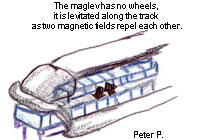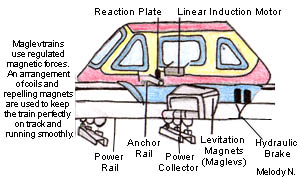
St. Mary's High School, Manhasset, NY
|
** Important Disclaimer ** |
||||||
Maglev
The Magnetic Levitation High Speed Train
Reesa A.
Approximately 25 years ago, scientists became interested in developing a train that would combine high-speed with a smooth ride and quiet operation. They developed the "Maglev", or magnetic levitation train. This vehicle rides on a cushion created by the electromagnetic repulsion between a series of on-board magnets and another embedded in the trackway below the train. Thus, this train does not run on wheels. As a result, the ride is very smooth and there is no metal-to-metal contact to generate noise and steel dust. Keeping this kind of Maglev train airborne and in smooth motion requires advanced, extremely accurate feedback circuits and very strict engineering tolerances. The other type of Maglev uses super-conducting coils embedded in the guideway and electromagnets in the train cars to establish the levitation.

Two American scientists at Lawrence Livermore National Laboratories have developed a new system called Indutrack which employs the use of passive permanent magnets, just like the ones on your kitchen refrigerator, only larger. In preliminary tests, Indutrack trains have higher lifting efficiency. Another big advantage of Indutrack is that it does not require the incorporation of superconductive coils in the guideway or in the bottom of the car. These coils require an extremely expensive, high maintenance, ultra-low temperature helium cooling systems. The new system consists of a series of passive magnets, called Halbach arrays, attached under the vehicle. The guide-way, which replaces the track or conventional subway and railroad trains, has metallic magnetic-inductive coils embedded in its surface. For each pound of the Halbach passive magnets, 50 pounds of vehicle/payload can be lifted.
There are two types of Maglev's: ones that use like magnets which repel each other and ones that use opposing magnets that attract with each other. Ones that use repelling magnets' are called Superconducting Maglev's. The magnets allow the train to float. Electromagnetic Maglevs use opposing magnets.
Superconducting Maglevs use very cold temperature magnets in order to make electricity without any opposition. The magnets are then put on the bottom of the train. When the train moves, it forms currents from the magnets in the aluminum sheets placed in the guideway. Because of the repelling force, the vehicle rises. Also in the guideway, separate electric currents pass through which push the train forward.
Electromagnetic Maglev's go under the guideway. They use opposing magnets that attract with each other. This allows the Maglev to pull upward towards the guideway. Like the superconducting Maglev's, separate currents make magnetic fields shift which allows the train to move forward. These Maglev's travel about 3/8's of an inch away from the guideway. In order for the magnets from not hitting the guideway, the lifting current must keep being fixed.

The main parts of the Maglev :
Guide way and guide rails - keep the train to on track
Landing wheels; levitation coils - run along the base of the guide way (used in superconducting mag-lev's)
Emergency landing wheel; superconducting magnets and propulsion coils - run along the base of guide way (used in electromagnetic
maglev's), and a linear induction motor - moves and brakes the vehicle on the track.
A Maglev vehicle generally has three different sizes:
|
Size |
Small |
Medium |
Large |
|
Passengers |
50 |
150 |
450 |
|
Freight (tons) |
12 |
40 |
120 |
|
Height (feet) |
12 |
13 |
13 |
|
Width (feet) |
8 |
13 |
13 |
|
Length (feet) |
40 |
100 |
260 |
|
Vehicle Weight (tons) |
12 |
30 |
80 |
By: Anne P. & Reesa A.
Works Cited
Coiley, John. Trains. New York: Dorling Kindersley, 1992.
Dixon, Malcolm. On the Railway. New York: Bookwright, 1984.
Johnson, Larry. "Magnetic Levitation Train." Microsoft Encarta Encyclopedia. CD-ROM. Microsoft, 1995.
"Magnetic Levitation." Concise Columbia Electronic Encyclopedia. CD-ROM. Columbia, 1994.
"Magnetism." Microsoft Encarta Encyclopedia. CD-ROM. Microsoft, 1995.
Powell, James. "Magnetic Levitation Trains." World Book Encyclopedia. Chicago: World Book, 1993.
Smerk, George. "Elevated Railroads'." Grolier Electronic Encyclopedia. CD-ROM. Grolier, 1992.
Warburton, Lois. Railroads Bridging the Continents. San Diego: Lucent, 1991.